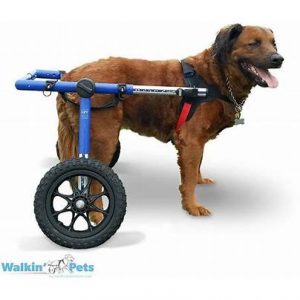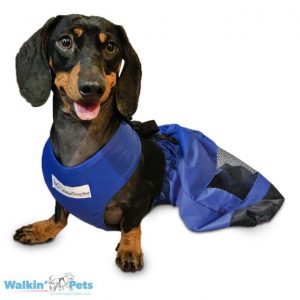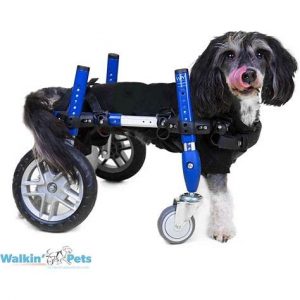WHEELCHAIRS: HOW TO GET MY DOG ON THE ROAD AGAIN
Tracie Grubb, DVM, CCRT, cVMA
Wheelchairs can be a great way to give your disabled dog added freedom and independence. But they are not for every dog. Here are a few things to think about when considering getting your dog in a cart.
MOBILITY ISSUES:
Is there a short-term mobility problem (i.e., surgical recovery) or a long-term problem (i.e., degenerative myelopathy, spinal cord disease, amputee)? Wheelchairs can accommodate dogs (and other animals) with front limb, rear limb, and missing limb problems. Yes, even amputees can benefit.
Wheelchairs can be used for activities ranging from daily walks and romps for cardiovascular support and environmental stimulation to assistance during rehabilitation sessions.

TYPES OF WHEELCHAIRS/CARTS:
If your dog has normal function of his/her front limbs, a rear support cart would be a good choice.
A dog with more advanced limitations may require a quad (4-wheel) cart. “Off-the-rack” carts offer numerous sizes and accessories while maintaining affordability. Custom carts are also available for more complicated cases.
WILL MY DOG BE SUPER STOKED ABOUT HIS WHEELS?!
Hmmmmm… I would say, yes….., no……, maybe. Some dogs get in the cart for the very first time and fly like the wind. Others take more time and much patience to adapt to their new way of moving. They will need to learn new tasks such as how to turn, stop, etc…. Your dog may look at you like you’ve lost your mind; but stick with it.
Positive rewards (not just food) can go a long way toward achieving the goal of successful wheelchair use. If they begin to associate the cart with joyful walks and time with family, that makes things easier in the long run.
IS THERE A “DOWN” SIDE TO A CART? I CAN ONLY SEE AN “UP” SIDE TO WHEELS.
The down side depends on your pet. A few things to note for ALL dogs:
- Your dog will NOT be able to lay down in the cart. That means no resting while they are in the cart. Therefore, wheels are used for limited activity only. Your dog should be removed from the cart when lounging around the house and/or for rest breaks during play time. *** Consider a “drag bag” for your dog to use when in the house to protect the body as they scoot along the floor. ****
2. Some dogs may feel comfortable urinating and defecating when in the cart; others will not.
3. Wounds from foot dragging, pressure points, etc… are possible. Monitor your dog’s skin regularly when using any support device.
4. Be prepared for the dog who may resent the cart. Again, patience is key.
HOW HARD IS IT TO PHYSICALLY GET A DOG IN THE CART?
Larger dogs can present more challenges simply due to their size. Some smaller dogs, however, are equally challenging if they are painful. It may take some finesse, but most families find a method that works best for them and their dog. The wheelchair company generally has support and/or videos to help, and your rehab professional also will have tips.

